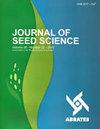用表型图像分析测定脱色剂和中和剂残留对棉花贮藏种子生理品质的影响
IF 1.2
4区 农林科学
Q3 AGRONOMY
引用次数: 0
摘要
摘要/ Abstract摘要:棉籽脱色可去除种皮上的皮棉,以提高可种植性和保持种子的生理品质,因此,本研究旨在通过图像分析表型分析来确定脱色和中和剂残留对棉籽贮藏生理品质的影响。试验采用3 × 4 × 2的随机因子设计,2个贮存期(0和180 d)。在3个不同的时间(2、4和10分钟)脱色棉籽,用4种不同的中和剂(生石灰、水合石灰、填充石灰和NaOH)中和,有中和剂残留和没有中和剂残留的棉籽。评价指标为:含水量、种子残皮棉成像、发芽、出苗、苗长成像。中和剂生石灰、水合石灰和填充石灰不需要从棉种皮上去除。在贮藏过程中,只有NaOH中和剂对棉籽品质的降低潜在性较强,其余中和剂去除棉籽残留后的生理品质都较低。图像分析表型是鉴定幼苗活力的有效方法。本文章由计算机程序翻译,如有差异,请以英文原文为准。
Delinting and neutralizers residue effect on stored cotton seeds physiological quality determined by phenotyping image analysis
Abstract: The cottonseed delinting removes lint from the seed coat to improve plantability and maintain the seed’s physiological quality, therefore, this work aimed to determine the effect of delinting and neutralizers’ residual on the physiological quality of stored cottonseed by using image analysis phenotyping. The experiment was a randomized factorial design of 3 x 4 x 2 and two periods of storage evaluation (0 and 180 days). The cotton seeds were delinted at three different times (2, 4, and 10 minutes), neutralized using four distinct neutralizers (Quicklime, Hydrated lime, Filler lime, and NaOH), and there were seeds with and without neutralizer residue. The evaluations carried out were: water content, seed residual lint imaging, germination, seedling emergence, and seedling length imaging. The neutralizers Quicklime, Hydrated lime, and Filler lime do not need removal from the cotton seed coat. In storage, only the neutralizer NaOH has a high latent effect in lowering cottonseed quality, and the other neutralizers have lower physiological quality when the residue is removed. The image analysis phenotyping is efficient in identifying seedlings’ vigor.
求助全文
通过发布文献求助,成功后即可免费获取论文全文。
去求助
来源期刊

Journal of Seed Science
Agricultural and Biological Sciences-Agronomy and Crop Science
CiteScore
2.00
自引率
30.00%
发文量
28
审稿时长
12 weeks
期刊介绍:
From 2017 the Journal of Seed Science (JSS) will circulate online version only.
Original scientific studies and communications, not yet published or submitted to another journal for publication and written in Portuguese or English, will be accepted for publication. For manuscripts submitted in English, the authors should provide an adequated version.
The SCIENTIFIC COMMUNICATION is a category of scientific manuscript which describes a technique, an equipment, new species or observations and surveys of limited results. It has the same scientific rigor as the “Scientific Articles” and the same value as a publication. The classification of a manuscript as a SCIENTIFIC COMMUNICATION is based on its content and scientific merit but it can be a preliminary study, simple and not definitive on a certain subject, with publication justified by its uniqueness and contribution to the area.
The Editorial Board of the JSS may invite leading authors of recognized reputation to compose specific Review Articles covering topics of their specialization that will convey to the scientific community the state-of-the-art knowledge related to the specific theme.
 求助内容:
求助内容: 应助结果提醒方式:
应助结果提醒方式:


